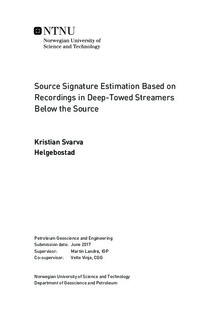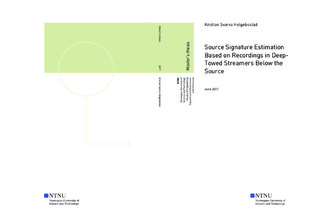| dc.contributor.advisor | Landrø, Martin | |
| dc.contributor.advisor | Vinje, Vetle | |
| dc.contributor.author | Helgebostad, Kristian Svarva | |
| dc.date.accessioned | 2019-09-11T09:00:55Z | |
| dc.date.created | 2017-06-09 | |
| dc.date.issued | 2017 | |
| dc.identifier | ntnudaim:16645 | |
| dc.identifier.uri | http://hdl.handle.net/11250/2615075 | |
| dc.description.abstract | Source-over-spread acquisition design is a recent development in marine seismic acquisition, aiming to improve imaging of the shallow subsurface. Contrary to conventional towed-streamer acquisition, source-over-spread acquisition records the direct wave below the source. We propose an inversion algorithm that takes advantage of the recordings of the direct wave in source-over-spread acquired seismic data to estimate notional source signatures for each air gun. The obtained notional source signatures from the inversion can be used to estimate directional far-field signatures, similar to the approach of notional source signatures estimated from measurements in near-field hydrophones.
The forward modeling of the algorithm is based upon a physical modeling of the air bubble created by each air gun in the source array. A damped Gauss-Newton approach is used as a local search algorithm to minimize the difference between the recorded direct wave and the modeled direct wave from the forward modeling. The inversion is first carried out for a low-frequency part of the data, before higher frequencies are included in the inversion. Typical inversion parameters are empirical damping factors for the bubble oscillations and firing time delay for each air gun. Variations in streamer depth are taken into account and a constant sea surface reflection coefficient is also estimated as a by-product of the inversion.
The algorithm is tested on shallow and deepwater data sets acquired with CGGs acquisition design called TopSeis. The notional source signatures are used in a designature flow and compared with designature results with notional source signatures from near-field hydrophone measurements. The results indicate that utilizing the direct wave in source-over-spread seismic can provide more accurate estimation of the strongest part of the bubble for deepwater data sets. To improve bubble estimation further, one may add more empirical factors to describe the oscillations of the bubble in the forward operator. It was furthermore observed that for shallow water data sets, subsurface reflections contaminated the bubble train of the direct wave. This affected the stability of the inversion, even when the water bottom reflection was included in the forward modeling. | en |
| dc.language | eng | |
| dc.publisher | NTNU | |
| dc.subject | Petroleumsfag, Petroleumsgeofysikk | en |
| dc.title | Source Signature Estimation Based on Recordings in Deep-Towed Streamers Below the Source | en |
| dc.type | Master thesis | en |
| dc.source.pagenumber | 102 | |
| dc.contributor.department | Norges teknisk-naturvitenskapelige universitet, Fakultet for ingeniørvitenskap,Institutt for geovitenskap og petroleum | nb_NO |
| dc.date.embargoenddate | 2020-06-09 | |

